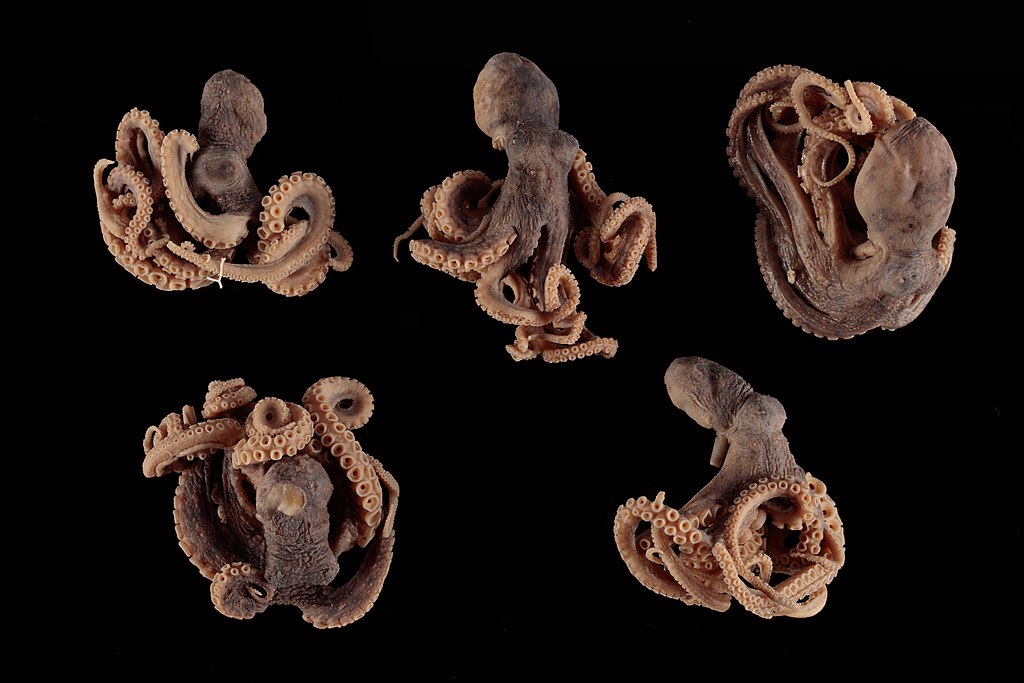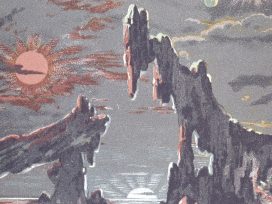Octopuses are having a moment. So are slime moulds and honeybees. Mushrooms are in vogue. After 250 years of humanity (well, some of humanity…) confidently atop the great pyramid of being, we in the West are becoming more aware that we might, perhaps, have company. The ingenuity and inventiveness of the natural world, its complexity and its collaboration, are becoming harder and harder to deny. Some people are even calling it intelligence.
Over the last five years, a cluster of books has brought these ideas to public attention. In 2016, Peter Godfrey-Smith published Other Minds: The Octopus, the Sea, and the Deep Origins of Consciousness, in which he argued that ‘evolution built minds twice over’, and octopuses’ invertebrate intelligence may shed light on what it means for us to be conscious, too. In 2019, Richard Powers’ novel The Overstory, about eight people’s lives connected through their relationship with trees, won the Pulitzer Prize for Fiction. In 2020, word of mouth lifted Robin Wall Kimmerer’s Braiding Sweetgrass, published seven years previously, into the New York Times bestseller list, for the vision it presented of mutual care and connection between people and plants. That year, Merlin Sheldrake published Entangled Life, another bestseller, exploring fungi and the ‘wood wide web’ of their mycorrhizal collaboration with plants.
Last year saw the arrival of two extraordinary books that weave these threads one step further: Ways of Being: Beyond Human Intelligence, by British artist, technologist and writer James Bridle, and The Mountain in the Sea, the first novel from American Ray Nayler. One is fiction, the other non-fiction – but they speak to the same themes: intelligence beyond the human, of not just plant and animal varieties, but artificial and technological as well.
Ways of Being sets about ‘expanding our definition of intelligence, and the chorus of minds which manifest it.’ Synthesising the work of ecologists and other scientists, Bridle (who uses they/them pronouns) seeks to explore the ‘multiple forms of being and doing, of living and thriving, structured across and interwoven between the many branches of the tree, or thicket, of life.’ Ultimately, they argue for a ‘technological ecology’ in which our recent creations might not distance us from nature, but instead help us better understand the collaboration and teeming complexity of the natural world.
The Mountain in the Sea is also a story about the meeting of more-than-human minds, encompassing humans, other animals and human technology. In the novel, rumour spreads of an unusual pod of octopuses living on a shipwreck off the Con Dao islands in Vietnam. They’re collaborating, signalling – perhaps even using (can it be?) language. Marine biologist Dr Ha Nguyen, who has spent her whole career researching cephalopod intelligence, is fascinated – and so is transnational tech corporation DIANIMA, which has bought and sealed off the archipelago and parachuted Dr Nguyen in, alongside the world’s first android robot, to find out what is going on.
Will the creatures offer unprecedented breakthroughs in artificial intelligence technology? Or do they just want to be left the hell alone? Nayler’s debut is equal parts a page-turning near-future thriller and a profound exploration of language, communication and otherness. Both books are exhilarating and kaleidoscopic. They draw on rich traditions of thought – geography, anthropology, ecology and systems science in the West, alongside older rural and Indigenous traditions of observation and being-in-relation with a place’s inhabitants. But this isn’t traditional nature writing in which ‘nature’ is opposed to ‘technology’. Quite the opposite. For both authors, artificial intelligences are simply ‘other minds’, a new human-made branch on the tree of life.
As Bridle writes, ‘We have already learned – from the gibbons, gorillas and macaques – that intelligence is relational: it matters how and where you do it, what form your body gives it, and with whom it connects.’ In this spirit, I spoke to both writers to understand the genealogy of these books in personal, as well as intellectual terms. How did the authors open their minds to other minds, and more-than-human worlds?
From octopuses to machine learning
For Nayler, it seems that The Mountain in the Sea was a lifetime in the making. ‘I wrote a report when I was maybe in fourth or fifth grade about octopuses,’ he told me. ‘And then I had spent this time in Vietnam as the environment, science, technology and health officer at the consulate in Ho Chi Minh City, and especially on Con Dao, working on a few different projects.’ Through his career in the United States Peace Corps and Foreign Service, Nayler lived and worked all over the world. But he found something exceptional in the remote Con Dao islands, off the southern coast of Vietnam. ‘I just grew to love that place, this very troubled environment: it’s a national park with a lot of issues with poaching, overfishing and other environmental degradation from the human population. And that place stuck with me as a place where I wanted to set a story.’

Mollusca cephalopoda octopoda, Auckland Museum Collections. Source: Wikimedia Commons.
Why octopuses specifically? ‘I wanted a first contact story that wasn’t with an alien, but with a species here on Earth. And that wasn’t about finding intelligent life – which is such a misnomer, because I think that wildlife is incredibly intelligent in very different ways – but that was about finding contact with an animal that had a symbolic level of communication, like we do.’
While Nayler looks at human-animal communication through science fiction, Bridle draws on a diversity of scientific research. ‘Humans have spoken to and with animals for as long as we have walked alongside them, which is forever,’ they write. One example relates to the Yao people of Mozambique, who forage for wild honey cooperatively with honeyguides – small brown birds who make distinctive calls to get Yao people’s attention, while the Yao vocalise a tongue-rolling ‘brrrrr-hm’ to call the birds in turn. The hunters triple their chances of finding a hive in the forest, while the birds benefit from the hunters’ sharp axes cutting open the tough hives, releasing the nutritious beeswax inside.
But it’s not just hunter-gatherers making the effort: computer scientists are, too. Ways of Being covers recent research from Google, MIT and the University of Arizona, such as the use of sensors and machine learning to classify patterns in whale song and prairie dog calls, in the hopes of figuring out the principles of their speech. Bridle values this attentiveness to other beings, but reminds us not to limit our aspirations: ‘Our goal should not be to master their languages, but rather to better understand animals’ lives in context, and thereby to alter our relationships with them in ways which are mutually beneficial.’
Nayler’s fictional octopuses might agree. When they finally choose to speak directly to Dr Ha Nguyen, one creature presents itself to her, letting her see the pictograms flashing across its mantle and ‘pouring through the chromatophores of its skin’. Its message is an insistence on their mutual consciousness. When, later, the octopuses start making physical, writing-like signs, it is not in order to engage further with humanity, but to utter a clear and unexpected instruction: ‘Fuck off.’ They wish to be left alone, their environment and emergent way of life undisturbed.
Language everywhere
Nayler’s interest in language ‘came out of my exploration of biosemiotics,’ he tells me: Jesper Hoffmeyer’s books Biosemiotics and Signs of Meaning in the Universe were particular inspirations. ‘If semiotics is the study of signs and sign systems, biosemiotics takes that and expands it to every single level of life,’ Nayler explained. ‘Biosemiotics is the study of signs at the level of the cellular, all the way up to complex human symbolic communication.’
‘It’s physical, of course,’ Nayler continued, ‘all sign exchange is physical and occurs in the world,’ from the electrical pulses that jolt through a nerve cell, to the pigment sacs that expand and contract in an octopus’s skin. ‘There’s nothing metaphysical about it. But you can’t really explain life without attending to the exchange of signs and signals processing. ‘Even a cell can process meaning’ is essentially the argument. That doesn’t mean that a cell has a brain, but it means that a cell can take inputs and interpret that input and do something.’
It’s an ontological shock: what if the capacity the human has for language, the thing we thought made us special, is not in fact unique to us, but actually something present across many different forms of life?
‘More-than-human doesn’t even begin to cover it,’ Bridle writes in Ways of Being. ‘Not only are we the products of multiple entangled ancestors, spanning vast ranges of the evolutionary field; we are not even individuals at all.’ Chapter 3, ‘The Thicket of Life’, explores one search for the origins of life through unravelling the ‘internal fossil record’ of DNA, RNA and proteins inside our cells. Cells not only signal to each other, Bridle explains, they’re deeply entangled ‘endosymbionts’. Deep in evolutionary history, scientists theorise, one bacterium engulfed another one and their hybridity became the cellular structures of mitochondria and chloroplasts, which produced the energy enabling complex, multi-cellular life.
Bridle’s writing here is joyful, almost delirious: ‘Frseeeeeeeefronnnng and we all go tumbling down the genetic line together . . . The lichens farm algae and we farm bacteria and each feeds the other, the trees are talking and everyone’s singing.’ I am not surprised to read that ayahuasca has been part of Bridle’s journey from London-based technologist to island-dwelling, regenerative-farming exploring, more-than-human thinker. ‘I have heard a plant speak, and I still don’t fully understand how, nor can I adequately describe the experience, but I know it to have happened, and it changed me utterly.’
Forest wisdom
More-than-human thinking isn’t just about recognising the near-to-human cleverness of certain animals, but recognising agency and interdependent relations across every kingdom of life, from the single-celled extremophiles known as archaeans, to fungi, animals and plants. For both writers, forests have been particularly inspiring environments.
Nayler said, ‘I had a short story a little while ago called “Eyes of the Forest”, and there’s a character in there that says, “It matters how you see the forest but what matters more is how the forest sees you.”’ His years in the Peace Corps in Turkmenistan taught him that communication exists in the space between self and other: not only in the intent of the speaker, but the perceptions and interpretation of the recipient, too.
Later on, he came across anthropological writing that brought this idea home. Indigenous Amazonian ‘perspectivism’ is the conception that ‘the world is inhabited by different sorts of subjects or persons, human and nonhuman, which apprehend reality from distinct points of view.’ Nayler pays homage to this tradition through the book-within-a-book in his novel, Dr Ha Nguyen’s monograph ‘How Oceans Think’ – a reference to anthropologist Eduardo Kohn’s How Forests Think.
For Bridle too, forests provided the germinal moment. ‘I had a series of encounters where it very much felt like the Universe was kind of knocking on the door and being like, hey, you need to pay attention to these things,’ Bridle told me. ‘The first direct encounter was with Suzanne Simard and her work in the forests of Western Canada. I was completely blown away by the things she explained about the way in which the forest was operating, the way the forests work and the way they live and the way they communicate and share resources.’
Simard’s research explores how roots and fungi form a network of communication and resource-sharing between trees. This research inspired Richard Powers’ novel The Overstory, which was also a catalyst for Bridle, who writes, ‘As I read it, I felt something shift in myself, a sense of having been blind all my life to events and processes, whole other lives that surround us all the time.’
Science and ecosystemic thinking
For both writers, moving away from their home countries of the UK and the US was important to the development of their thinking – but moving away from big global cities to more rural and peripheral locations proved even more impactful.
‘Living in different cultures has a huge effect because it makes you question everything that you know,’ Bridle told me. ‘Examining the assumptions of one’s own culture is the necessary prerequisite for any kind of new critical thinking.’ In particular, moving to a small Greek island enabled ‘a much more intense and personal relationship with the more-than-human world than I’d had previously in my whole life’. For Nayler, his time living in Turkmenistan with the Peace Corps revealed to him all the ways in which his American culture was in fact the strange and ‘alienating’ one, in contrast to the slower-paced, highly social Turkmen life.
Ways of Being refers extensively to Indigenous thought, from Tyson Yunkaporta on thinking with stones, to the sortition voting methods of the Haudenosaunee (Iroquois) Confederacy. When we spoke, however, Bridle told me how they were not solely seeking traditional ecological knowledge or models of alternate social relations from outside European cultures, but also from within:
I was looking to people in Greece, to histories of magic in southern Italy, to traditional folk music: I cite the Sami joikers or Corsican and Sardinian folk singers. I’ve learned as much from people who forest forage for plants on my own island and the relationship they have with them as I have by reading about plant work in the Americas or elsewhere. So I do think it’s possible to learn from one’s own traditional knowledge as well.
Some writers might react against the western capitalist worldview by fetishising traditional rural or Indigenous lifeways. Instead, Bridle and Nayler are attempting something more interesting: a counter-reading of western science that finds there has been space for ecosystemic thinking and more-than-human community all along. Recall Braiding Sweetgrass, by Robin Wall Kimmerer, who is both an enrolled member of the Citizen Potawatomi Nation and Professor of Environmental and Forest Biology at the State University of New York (SUNY). In a 2017 magazine interview, Kimmerer said that ‘I wanted readers to understand that Indigenous knowledge and western science are both powerful ways of knowing, and that by using them together we can imagine a more just and joyful relationship with the Earth.’ Connection and interdependence might be lessons from Indigenous thought and ecology both.
‘Systems thinking has been fighting its way into public and academic awareness for a very long time,’ Nayler told me, ‘starting maybe even as early as the late 19th century.’ As Nayler points out, it’s a theme that appears in Charles Darwin’s On The Origin of Species, in which he emphasises that the key point is not the struggle for survival in one species, but a tangle of interconnected life:
It is interesting to contemplate a tangled bank, clothed with many plants of many kinds, with birds singing on the bushes, with various insects flitting about, and with worms crawling through the damp earth, and to reflect that these elaborately constructed forms, so different from each other, and dependent upon each other in so complex a manner, have all been produced by laws acting around us.
Bridle also recruits Darwin as an early ally to the cause of more-than-human thought. In 1838 the naturalist took to visiting an orangutan named Jenny at London Zoo, bringing her a mouth organ to play on. ‘Let man visit Ouranoutang in domestication . . . see its intelligence . . . and then let him boast of his proud preeminence,’ Darwin wrote in his notebook.
‘A new Copernican trauma’?
Systems theory is an interdisciplinary field, based on the principle of studying systems holistically, rather than as atomised parts. In 1948 came Norbert Wiener’s founding work Cybernetics: Or Control and Communication in the Animal and the Machine, which developed the idea of self-organising systems. In 1972, Donella Meadows and colleagues published ‘The Limits To Growth’ report, based on the global computer model they’d developed, evaluating the circumstances that would lead to environmental collapse. At the same time, James Lovelock was developing Gaia theory: the idea of the Earth and its inhabitants as a self-regulating whole.

AI-generated image. Prompt: ‘1990s home movie footage of iridescent artificial intelligence’ via Midjourney v4, seeded prompt with “no AI” image that was circulating on ArtStation during the AI art protest. By Cameron Butler via Wikimedia Commons.
Nayler observed that ‘I think the reason systems theory feels like it’s everywhere right now is because it’s finally starting to bubble to the surface in public discourse, after having been an argument that’s been going on in science for generations. My counter question would just be why it seems to have taken such a long time to address what seems to be obvious, actually, to quite a few people for a very long time.’
So, why now? ‘We’re all desperately searching for a way of making sense of a world that has clearly gone quite horrifically in the wrong direction, and is proceeding further in that direction all the time,’ Bridle said when I put this to them. ‘And so there’s a need for new knowledge and new understandings. We need to build those actively. It requires thought, it requires the construction of new models and metaphors of how the world works.’
We live in a doubly existential moment. We have named an entire geological era, the Anthropocene, for our abilities to terraform the planet – and yet we fear that we are unable to terraform our own culture enough to make it compatible with sustaining life. Meanwhile, as Bridle writes, ‘the new-found sophistication of our own technologies threatens to supersede us.’
This summer, AI image-generation tools have raised questions over what we had thought to be the most human of skills: artistry. Meanwhile, ‘longtermist’ thinkers fret over the risks of artificial general intelligence – the name given to the prospect of AI becoming able to learn flexibly and meet or exceed human intellectual capabilities. Bridle describes this as ‘a new Copernican trauma’, ‘wherein we find ourselves standing on a ruined planet, not smart enough to save ourselves, and no longer by any stretch of imagination the smartest living things around.’ Through ecology and technology both, we come to a new cosmology in which man is no longer the centre of the universe – which may be, for some, a shock. Nayler’s novel raises the same predicament. In it, Dr Ha Nguyen writes:
Communication is communion. When we communicate with others, we take something from them into ourselves, and give them something of ours. Perhaps it is this thought that makes us so nervous about the idea of encountering cultures outside the human. The thought that what it means to be human will shift – and we will lose our footing. Or that we will have to finally take responsibility for our actions in this world.
Bridle agrees, writing that ‘Our very survival depends upon our ability to make a new compact with the more-than-human world, one which views the intelligence, the innate being of all things – animal, vegetable and machine. . . as an urgent call to humility and care.’
It’s both a very old idea and the leading edge of contemporary thought. Bridle insists passionately that ‘All of this efflorescence of new thinking in this area is new thinking, even if a lot of it draws upon traditional knowledge and Indigenous practices, or obscure critical theory, or quite complex novel scientific thinking. All of it is new thinking, because it’s being done by new people and phrased in different ways that allows it to be understood in new ways. And it constructs new people by doing that.’
Because that is the work to be done. The ultimate gift of this more-than-human thinking might be to make us more humane.








